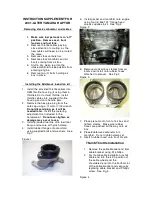
SAFETY
70
TC (Traction Control)
SYSTEM
The system automatically operates
in the event of slipping, loss of grip
on wet roads (aquaplaning) and
acceleration on slippery, snowy or
icy roads, etc. on one or more drive
wheels. Depending on the slipping
conditions, two different control
systems are activated:
if the slipping involves both drive
wheels, the system intervenes,
reducing the power transmitted by the
engine;
if the slipping only involves one of the
drive wheels, the BLD (Brake Limited
Differential) function is activated,
automatically braking the wheel
which is slipping (the behaviour of a
self-locking differential is simulated).
This will increase the engine torque
transferred to the wheel which isn't
slipping.
This function remains active even
if the "Systems partially disabled"
and "Systems disabled" modes
are selected (see description in the
following pages).
System intervention
The system intervention is signalled
by the blinking of the instrument panel
warning light
, to inform the driver
that the car is in critical stability and
grip conditions.
44) 45) 46) 47) 48)
PBA (Panic Brake
Assist) SYSTEM
The PBA system is designed to
improve the vehicle’s braking capacity
during emergency braking.
The system detects emergency braking
by monitoring the speed and force with
which the brake pedal is pressed, and
consequently applies the optimal brake
pressure. This can reduce the braking
distance: the PBA system therefore
completes the ABS.
Maximum assistance from the PBA
system is obtained by pressing the
brake pedal very quickly. In addition,
the brake pedal should be pressed
continuously during braking, avoiding
intermittent presses, to get the most
out of the system. Do not reduce
pressure on the brake pedal until
braking is no longer necessary.
The PBA system is deactivated when
the brake pedal is released.
49) 50) 51)
HSA (Hill Start Assist)
This is an integral part of the ESC
system and facilitates starting on
slopes, activating automatically in the
following cases:
uphill: vehicle stationary on a road
with a gradient higher than 5%,
engine running, brake pressed and
transmission in neutral or gear other
than reverse engaged;
downhill: vehicle stationary on a road
with a gradient higher than 5%, engine
running, brake pressed and reverse
gear engaged.
When setting off, the ESC system
control unit maintains the braking
pressure on the wheels until the
engine torque necessary for starting is
reached, or in any case for a maximum
of 2 seconds, allowing your right foot to
be moved easily from the brake pedal
to the accelerator.
When the 2 seconds have elapsed,
without starting, the system is
automatically deactivated, gradually
releasing the braking pressure.
During this release stage, the typical
mechanical brake release noise can be
heard, indicating that the car is about
to move.
52) 53)
DST SYSTEM (Dynamic
Steering Torque)
The DST function uses the integration
of the ESC system with the electric
power steering to increase the safety
level of the whole car.
In critical situations (braking on
surfaces with different grip conditions),
Summary of Contents for 500x
Page 10: ......
Page 106: ...SAFETY 104 Passenger s front airbag and child restraint systems IMPORTANT 87 F1B0129C...
Page 229: ...227 Uconnect Radio CONTROLS ON FRONT PANEL 188 F1B0623C...
Page 239: ...237 Uconnect 7 HD LIVE Uconnect 7 HD Nav LIVE CONTROLS ON FRONT PANEL 192 F1B0769...
Page 260: ......
Page 262: ......
Page 263: ......
Page 265: ...NOTES...
Page 266: ......
















































